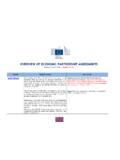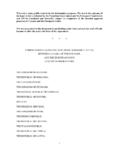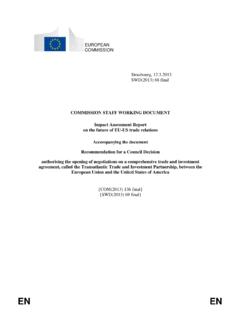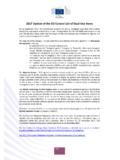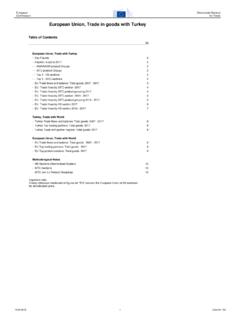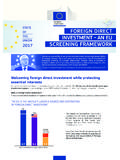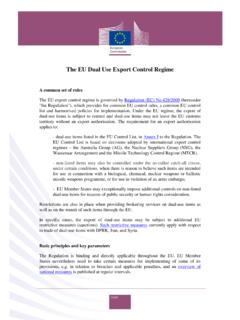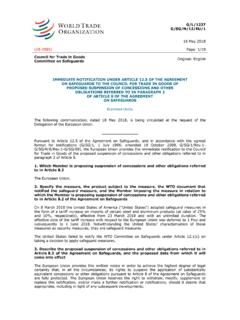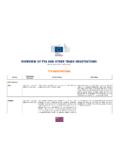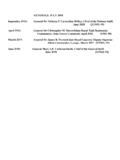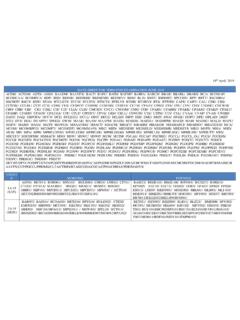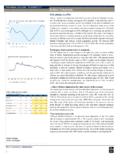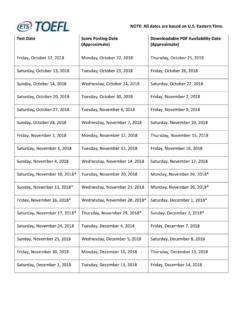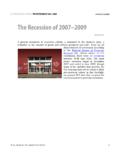Transcription of Annual Report on the Implementation of the EU-Korea Free ...
1 EN EN EUROPEAN COMMISSION Brussels, COM(2016) 268 final Report FROM THE COMMISSION TO THE EUROPEAN PARLIAMENT AND THE COUNCIL Annual Report on the Implementation of the EU-Korea Free Trade Agreement {SWD(2016) 162 final} 2 Report FROM THE COMMISSION TO THE EUROPEAN PARLIAMENT AND THE COUNCIL Annual Report on the Implementation of the EU-Korea Free Trade Agreement 1. Introduction 1 July 2015 marked the fourth anniversary of the Free Trade Agreement (FTA) between the EU and its Member States and the Republic of Korea ( Korea ).
2 The FTA has been provisionally applied since July 2011. On 13 December 2015, it entered formally into force following the ratification by EU Member States. The EU-Korea FTA is the first of a new generation of FTAs, characterised by its far-reaching and comprehensive nature. It is also the EU's first trade deal with an Asian country and the most ambitious FTA implemented by the EU so far. The FTA has already seen its first amendment. The Additional Protocol to the FTA to take into account Croatia s EU accession was signed in March 2014 and provisional application started on 26 May 2014.
3 It entered into force on 1 January 2016. This is the fourth Annual Report on the Implementation of the FTA, in accordance with the provisions of Regulation (EU) No 511/2011 of the European Parliament and of the Council of 11 May 2011 implementing the bilateral safeguard clause of the Free Trade Agreement between the European Union and its Member States and the Republic of Korea1. According to Article 13(1) of the said Regulation, the Commission shall make public an Annual Report on the application and Implementation of the Agreement.
4 Furthermore, Article 3(3) stipulates that the Commission shall present an Annual monitoring Report to the European Parliament and the Council on updated statistics on imports from Korea of products in the sensitive sectors and those sectors to which monitoring has been extended. This Report therefore combines these two reporting requirements. The evolution of EU imports from Korea in the sectors covered by the monitoring and the results of the specific monitoring on duty drawback are presented in the Commission Staff Working Document attached to this Report .
5 The Report also gives an overview of the activities of the various committees and working groups established under the FTA to monitor the Implementation of the agreement. Since most of these met in the second half of 2015, this Report covers the period July 2014 until December 2015. The analysis of trade statistics covers the fourth Implementation year, July 2014 to June 2015 to allow for a comparison with the corresponding 12-month period before the FTA took effect, whereas the summary of the activities of the FTA Implementation bodies covers the calendar year 2015.
6 1 OJ L 145, , p. 19 3 2. OVERALL ASSESSMENT: EVOLUTION OF TRADE AFTER FOUR YEARS OF FTA Implementation Methodology used for the analysis The below analysis of the bilateral trade flows for goods between the EU and Korea is based on a comparison of data for the fourth year of Implementation of the FTA (July 2014 June 2015) with the 12-month period before the FTA took effect and provisional application started (July 2010 June 2011).
7 As regards trade in services, the analysis is based on Annual data until 2014. It should be noted that changes in trade flows cannot be attributed solely to the FTA, as also other factors influence trade flows. However the figures provided below give a good indication of how the FTA has worked so far. Overall evolution of trade in goods EU exports to Korea increased by 55%, from billion EUR in the 12-month period before the FTA took effect to billion EUR in the fourth year of the FTA.
8 The Annual increase in exports was more than 15% in the first year of FTA implementation2, 8%-9% in the second and third years and 14% in the fourth year. EU exports to Korea of products that were fully or partially liberalised by the FTA grew by 57% and 71% respectively compared to the 12-month period before the FTA took effect (by billion EUR and billion EUR respectively), whereas EU exports of products subject to zero MFN tariff grew by 25% ( billion EUR). The respective growth of EU exports to the world3 of these products was 19% for the fully liberalised products, 26% for the partially liberalised products and 13% for the zero MFN products.
9 Graph 1: EU Exports to and Imports from Korea, July 2010-June 2015 (billion EUR) 2 First year of FTA Implementation (July 2011-June 2012), second year (July 2012-June 2013), third year (July 2013-June 2014), fourth year (July 2014-June 2015). 3 This refers to extra-EU trade only, trade with EU Member States is excluded. 4 Source: EUROSTAT-COMEXT (extracted in October 2015) EU imports from Korea in the fouth year of the FTA amounted to billion EUR, having increased by 5% since the 12-month period before the entry into effect of the FTA.
10 In the third and fourth years of Implementation , imports increased annually by 6%, whereas in the second year they decreased by 6% compared to the previous year. It is worth noting that in the fourth year of FTA Implementation , EU imports from Korea increased more than EU imports from the world, which increased by 2% compared to the previous year. EU imports from Korea of products that were fully or partially liberalised by the FTA grew by 35% and 64% respectively compared to the 12-month period before the entry into effect of the FTA (by billion EUR and billion EUR respectively), whereas EU imports from Korea of products subject to zero MFN tariff decreased by 29% (by billion EUR).
